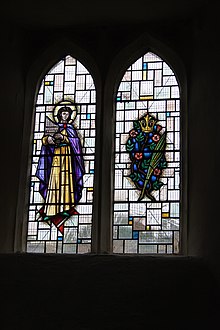| River Chew | |
|---|---|
 River Chew between Stanton Drew and Pensford River Chew between Stanton Drew and Pensford | |
 Topographical map of the Chew Valley Topographical map of the Chew Valley | |
| Location | |
| Country | England |
| County | Somerset |
| District | Chew Valley |
| Physical characteristics | |
| Source | Chewton Mendip |
| • location | Mendip Hills, Somerset, England |
| • coordinates | 51°16′34″N 2°34′42″W / 51.27611°N 2.57833°W / 51.27611; -2.57833 |
| • elevation | 305 m (1,001 ft) |
| Mouth | River Avon, Bristol |
| • location | Keynsham, Somerset, England |
| • coordinates | 51°25′29″N 2°30′26″W / 51.42472°N 2.50722°W / 51.42472; -2.50722 |
| • elevation | 10 m (33 ft) |
| Length | 27 km (17 mi) |
| Basin size | 145 km (56 sq mi) |
| Discharge | |
| • location | Keynsham |
| • average | 1.18 m/s (42 cu ft/s) |
| • minimum | 0.5 m/s (18 cu ft/s) |
| • maximum | 20 m/s (710 cu ft/s) |
| Basin features | |
| Tributaries | |
| • left | Strode Brook, Winford Brook |
The River Chew is a small river in England that flows for some 17 miles (27 km) through the North Somerset countryside to form the Chew Valley before merging with the River Avon.
The spring from which the Chew rises is just upstream from Chewton Mendip. Strode Brook and Winford Brook are the main tributaries, both joining the Chew from the left. The river flows northwest from Chewton Mendip through Litton, Chew Valley Lake, Chew Stoke, Chew Magna, and Stanton Drew. The river passes under the A37 at Pensford; flows through the villages of Publow, Woollard, Compton Dando, and Chewton Keynsham; and joins the River Avon at Keynsham. The Two Rivers Way runs alongside the Chew for much of its distance, forming part of the Monarch's Way.
The name "Chew"
The name "Chew" may have Celtic origins, cognate with the River Chwefru, cliwyf-ffrenwy, "the moving, gushing water"; ancient forms are Estoca (Chew Stoke), Chiu (Chew Magna), and Ciwetune (Chewton Mendip). Its exact meaning admits of several possible explanations, including "winding water", the ew being a variant of the French eau, "water". The word chewer is western dialect for "narrow passage" and chare is Old English for "turning."
Another theory is that the name derives from the Welsh cyw, "the young of an animal, or chicken", such that Afon Cyw would have meant "the river of the chickens".
Other possible explanations are it comes from the Old English word cēo ("fish gill"), used in the transferred sense of a ravine, in a similar way to Old Norse gil, or possibly a derogatory nickname from Middle English chowe, "chough", Old English cēo, a bird closely related to the crow and the jackdaw, notorious for its chattering and thieving. Still another suggestion is that the river is named after the Viking war god Tiw.
Course
The current course of the river was likely established after the last ice age, before which the river had probably followed the course of the Congresbury Yeo to the Bristol Channel. Ice blocking the Bristol Channel would have diverted the Chew such that it flowed north rather than west through Compton Martin to join the Avon.
Roman use
"Pigs" (ingots) of lead from the Charterhouse Roman Town on Mendip were brought to the river to be transported to Sea Mills on the Avon for shipment overseas.
Flood of 1968

The Chew Stoke flood of 1968 caused serious damage to towns and villages along its path, sweeping away the bridge at Pensford.
Fishing
Fish ladders have been installed at three weirs in Keynsham and Chewton Keynsham to allow fish to travel upstream. Fishing rights for the Millground and Chewton sections of the river are owned by Keynsham Angling Club. The Mill Ground stretch of the River Chew consists of the six left-bank fields (looking downstream) from Chewton Place at Chewton Keynsham to the Albert Mill, Keynsham. The water is home to numerous species of fish, including chub, roach, European perch, rudd, gudgeon, dace, grayling, trout, and eel.
References
- "River Chew – Somerset Rivers". Retrieved 19 October 2020.
- "Notes on the names of parishes in the county of Somerset", Notes and Queries 15 September 1883:204, drawing upon Eyton, Domesday Studies and Collinson, Somerset.
- "History of the River Chew". River Chew Web Site. Retrieved 3 July 2006.
- Ekwall, Eilert (1928). English River-Names. Oxford University Press. ISBN 0-19-869119-X.
- "What we know about the Chew Family". Retrieved 3 July 2006.
- Robinson, Stephen (1992). Somerset Place Names. Wimbourne: The Dovecote Press Ltd. ISBN 1-874336-03-2.
- Haslett, Simon K. (2010). Somerset Landscapes: Geology and landforms. Usk: Blackbarn Books. pp. 116–118. ISBN 9781456416317.
- Havinden, Michael. The Somerset Landscape. The making of the English landscape. London: Hodder and Stoughton. p. 71. ISBN 0-340-20116-9.
- "The great flood of 1968". Memories of Bristol. Archived from the original on 2 May 2006. Retrieved 4 January 2006.
- Richley, Rob (June 2008). The Chew Valley floods of 1968 (PDF). Exeter: Environment Agency.
- "River Chew". Keynsham Angling Club. Retrieved 5 June 2014.
External links
For further information, visit the dedicated River Chew website at www.riverchew.co.uk.
Gallery
-
Bridge at Pensford.
-
Bridge at Publow.
-
Bridge at Stanton Drew.
| Chew Valley | |
|---|---|
| Towns and villages: |
|
| Reservoirs: | |
| Rivers: | |
| SSSIs: | |
| Open Access Land |
|
| Councils: | |
| Surrounding areas: | |